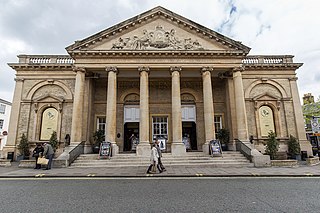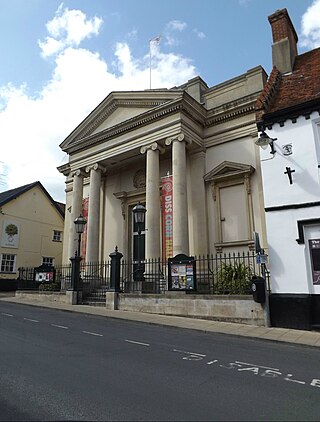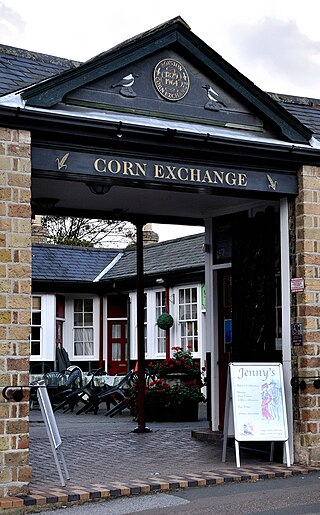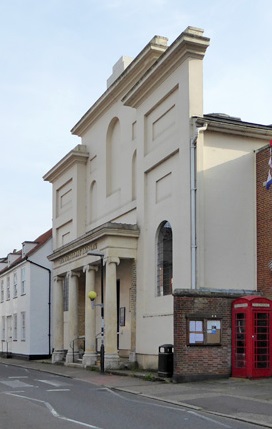
Bishop's Stortford is a historic market town in Hertfordshire, England, just west of the M11 motorway on the county boundary with Essex, 27 miles (43 km) north-east of central London, and 35 miles (56 km) by rail from Liverpool Street station. Stortford had an estimated population of 41,088 in 2020. The district of East Hertfordshire, where the town is located, has been ranked as the best place to live in the UK by the Halifax Quality of Life annual survey in 2020. The town is commonly known as “Stortford” by locals.

East Hertfordshire is one of ten local government districts in Hertfordshire, England. Its council is based in Hertford, the county town of Hertfordshire. The largest town in the district is Bishop's Stortford, and the other main towns are Ware, Buntingford and Sawbridgeworth. At the 2011 Census, the population of the district was 137,687. By area it is the largest of the ten local government districts in Hertfordshire. The district borders North Hertfordshire, Stevenage, Welwyn Hatfield and Broxbourne in Hertfordshire, and Epping Forest, Harlow and Uttlesford in Essex.

Bishop's Stortford Football Club is a football club based in Bishop's Stortford, Hertfordshire, England. They are currently members of the National League North and play at Woodside Park.

A corn exchange is a building where merchants trade grains. The word "corn" in British English denotes all cereal grains, such as wheat and barley; in the United States these buildings were called grain exchange. Such trade was common in towns and cities across England until the 19th century, but as the trade became centralised in the 20th century many such buildings were used for other purposes. Several have since become historical landmarks.

The A120 is an A-road in England, which runs between Puckeridge in Hertfordshire and Harwich in Essex.

The Corn Exchange is a commercial building in Cornhill, Bridgwater, Somerset, England. The structure, which is now used as a shopping arcade, is a Grade I listed building.

Marden Hill is a Grade II* listed country house close to the village of Tewin, Hertfordshire.

St Albans Town Hall, sometimes known as the Old Town Hall or The Courthouse, is a 19th-century building in St Albans, Hertfordshire, England. The building, which now accommodates the St Albans Museum, is a Grade II* listed building.

The Shire Hall is a municipal building in Fore Street, Hertford, the county town of Hertfordshire, England. The building, which currently serves as a Magistrates' Court, is a Grade I listed building.

Corn exchanges are distinct buildings which were originally created as a venue for corn merchants to meet and arrange pricing with farmers for the sale of wheat, barley, and other corn crops. The word "corn" in British English denotes all cereal grains, such as wheat and barley. With the repeal of the Corn Laws in 1846, a large number of corn exchanges were built in England, particularly in the corn-growing areas of Eastern England.

The Corn Exchange is a commercial building on Fore Street in Hertford, Hertfordshire, England. The structure, which is currently used as an events venue, is a Grade II listed building.

The Albert Hall is a commercial building in the High Street, Colchester, Essex, England. The structure, which was commissioned as a corn exchange and is now used as a bank, is a Grade II listed building.

The Corn Exchange is a commercial building in Tuesday Market Place, King's Lynn, Norfolk, England. The structure, which was commissioned as a corn exchange and is now used as an events venue, is a Grade II listed building.

The Corn Exchange is a retail building in the Market Place, St Albans, Hertfordshire, England. The structure, which is now used to accommodate a pair of shops, is a locally listed building.

The Corn Exchange is a commercial building in The Pantiles, Royal Tunbridge Wells, Kent, England. The structure, which is currently used as an antiques and fine art market, is a Grade II listed building.

The Corn Hall is a commercial building in St Nicholas Street, Diss, Norfolk, England. The structure, which is now used as an arts centre, is a Grade II listed building.

The Corn Exchange is a commercial building on Market Hill in Royston, Hertfordshire, England. The structure, which is now used as a series of retail units organised round a central courtyard, is a Grade II listed building.

The Corn Exchange is a commercial building in the High Street in Manningtree, Essex, England. The structure, which is now used as a public library, is a Grade II listed building.

The Corn Exchange is a commercial building in Exchange Square in Beccles, Suffolk, England. The structure, which is now used as a branch of Lloyds Bank, is a Grade II listed building.





















